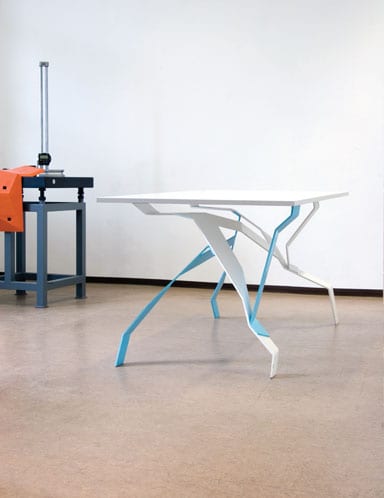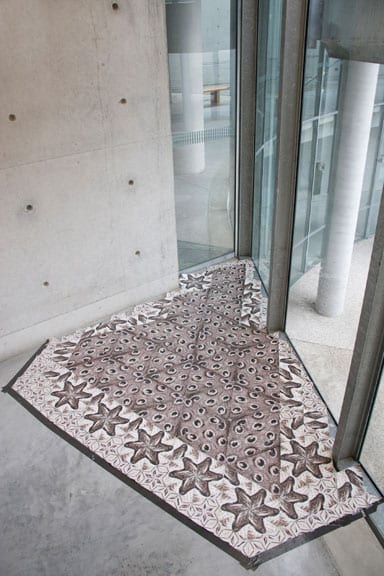
words Justin McGuirk
The sci-fi writer and blogger takes a look at the background aesthetic of the future, generative design: patterns and forms conjured out of programmed randomness.
You’ve just been doing a workshop on generative design at Fabrica. Can you explain what generative design is and why you’re interested in it?
What interests me most is that it’s really unusual looking. It’s sort of unimaginable by 20th-century standards. And it’s easy to make a declaration like that, that sounds very science-fictional, but when you’ve got one of these giant, spiny “whatevers” in front of you, it really makes a believer of you.
It’s not like you need to have some particular software environment, or even a computer to use generative techniques. A tie-dye shirt is generative design, because you’ve set up a process, you don’t quite know the outcome, and you hope it will have some regularities and some surprises, and you get an effect which you could not have imagined fully before you began the process.
So it’s about chance?
Well, yes, chance, and about recursion – repeating the same processes over and over until you get emergent regularity. Processing is seven years old, it’s not going to last for ever. The machines on which people are doing generative art are going to die very fast. If it’s going to become anything it’ll have to be device-independent.
We’re just getting started. Discussions like this are necessary at this point. There are no textbooks on generative design, there’s no generative design university. There haven’t even been any serious arguments about it yet, there are no manifestos, there’s been no bloodletting – you know, it’s very nebulous.
What generative designers are you interested in?
I’m keenly interested in Ben Fry and Casey Reas, two information visualisation guys who came out of John Maeda’s MIT computer aesthetics lab. But I think they would call themselves information visualisation people, as opposed to artists or designers.
You’ve got people like Greg Lynn and Kram/Weisshaar exploring these techniques, but not that many designers are taking it up, it seems, compared to artists or computer graphics people.
Well, it’s got a small niche. When I was doing a similar seminar at the Sandberg Institute in Amsterdam, we went to the local Ikea to look for generated imagery, and we found about 25 or 26 objects which either had generated patterns in fabric, or generated graphics applied to them – usually it’s some kind of surface treatment. There was only one object which seemed to have been generated. It was a steel fruit bowl with a hole in the form, which had clearly been made by some kind of laser-cutting process.
In what way are those patterns generative, because haven’t they just been drawn on a computer?
No, they were clearly programmed. Somebody has set up some kind of process which is spewing little daisies or flowers or whatever, and they’re watching this home-made processing style video firing away, and waiting for it to do something photogenic, then it’s “click, print, ship”. That’s classic generative art, and the thing that’s cool is that it doesn’t look composed, because it isn’t – it’s more like nature photography or something. And second is that once you’ve set up the process it’s quite cheap.
You’ve been asking whether this kind of work is any good or not. That’s a provocative and necessary question.
Yes, it is indeed. Well, I don’t think I’m at the point of writing a manifesto just yet because I haven’t figured out the answer. I’m still experimenting with it and I’m even just trying to find the people in the field who seem to be the most advanced. And it’s not a hugely crowded field of people – they all seem to know one another, and they’re all loosely clustered around Reas and Fry. There don’t seem to be any regional centres for generative practice, except maybe MIT, and everybody involved at MIT has left. Maeda’s president of Rhode Island School of Design; Reas is teaching in UCLA. Fry, I forget what the heck the guy’s up to, something nebulous and important. But clearly something’s nucleated there and they’re busily spreading the word and access to the tools.
Most magazines just aren’t covering this stuff.
It’s too new to cover. I mean, not only is it too new to cover, it may be that there’s just not a lot going on there. A kaleidoscope is generative, and you could invent a kaleidoscope, and it’s a start. And you give a seven-year-old a kaleidoscope and he’s like “Wow, thank you, uncle”. But you twist it and it doesn’t get better – there’s no such thing as kaleidoscope criticism. There’s not a method by which you say: “Well, I twisted it to the right, and then I twisted it to the left and, wow, it was really good. And then I twisted it one more time and, gosh, what a shame.” A kaleidoscope is a toy, it’s not fine art, it cannot sustain criticism.
So would you say that we’re still waiting to see the first mature piece of generative design?
I’ve seen one or two pieces that I thought would be really interesting in 20 years. And as a technique it’s quite interesting, you just need a lot of non-repeating patterns. But it’s sort of like asking “When are we going to get the first techno symphony made out of sample loops and backing tracks that’s as great as Mozart?” I really like techno music, I’m quite the fan. I would never dismiss it. And I don’t want this to be interpreted as a hostile remark about techno, but the fact that it’s machine-generated music is difficult, almost like criticising a hurdy-gurdy in some way.
For me some of this work falls down conceptually. Take the Breeding Tables by Kram/Weisshaar. In theory it’s parametric, so you feed in a set of parameters that generates a series of versions, and then ultimately you pick the one that looks nicest. You might as well have just drawn the one that looks nicest, do you know what I mean?
I completely agree. I mean, you’ve gone through a lot of hokey-pokey there and then you’ve got some output which does not look especially remarkable. There are severe problems with it. It’s like a screensaver: you’re looking at your screensaver, which is generative, and it does this kind of cool psychedelic thing and then it starts doing this sort of really unfortunate train-wreck thing, and there’s no control. You know? You sort of get a lot of garbage, and then occasional moments of semi-accidental visual brilliance. OK, that’s a very difficult thing to criticise and assess, and then make coherent use of. And it kind of reduces it to the level of “stuff”, or a kaleidoscope.
Is there potential for mass production?
Yeah. In fabric design, this stuff is going to rule. In wallpaper, I think it’s got some really good uses. This stuff in Ikea has a lot of this going on. In advertising you see a lot of generative techniques. And mostly I think there’s a lot of niche applications and lots of things that are peripheral to our attention. If you don’t look at it too closely, if it’s just sort of going on ambiently in the background, kind of like visual muzak, that’s really good. Whether we’re going be sitting around in galleries looking at framed pieces of generative art – I really doubt that.




















